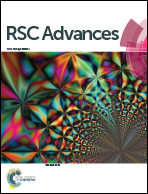Pyrochlore Ta-doped antimony oxide as a novel adsorbent for efficient strontium removal†
Abstract
Hydrous antimony oxide Sb2O5·4H2O with a pyrochlore structure is an ion exchanger that is selective toward Sr2+ in mild solutions. The present study aims to improve the Sr2+ adsorption capacity of antimony oxide. Cubic pyrochlore non-doped and Ta-doped antimony oxide nanoparticles were prepared by a hydrothermal method. The particles were characterized by X-ray diffraction (XRD), scanning electron microscopy (SEM), transmission electron microscopy (TEM), N2 gas sorption, Fourier transform infrared spectroscopy (FT-IR), and X-ray photoelectron spectroscopy (XPS). Incorporation of Ta5+ into the sorbent led to an expansion of the pyrochlore structure, and increases in the surface hydroxyl group content and surface area of the sorbent, consequently improving the Sr2+ adsorption capacity considerably. A satisfactory correlation coefficient and a relatively low normalized standard deviation of the fit of the experimental data using the Freundlich model demonstrate that Sr2+ adsorption onto Ta-doped antimony oxide proceeds via a multilayer chemical adsorption process. Thermodynamic studies were conducted under different reaction temperatures. The results indicate that Sr2+ adsorption onto Ta-doped antimony oxide is an endothermic and a spontaneous process. Under the current experimental conditions, the maximal Sr2+ adsorption capacity of 26.37 mg g−1 was obtained at pH 4.


 Please wait while we load your content...
Please wait while we load your content...